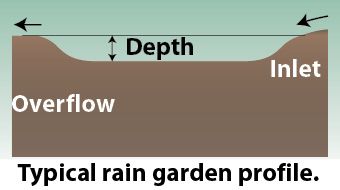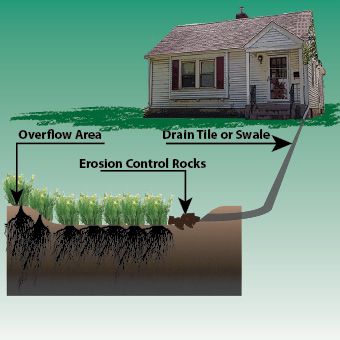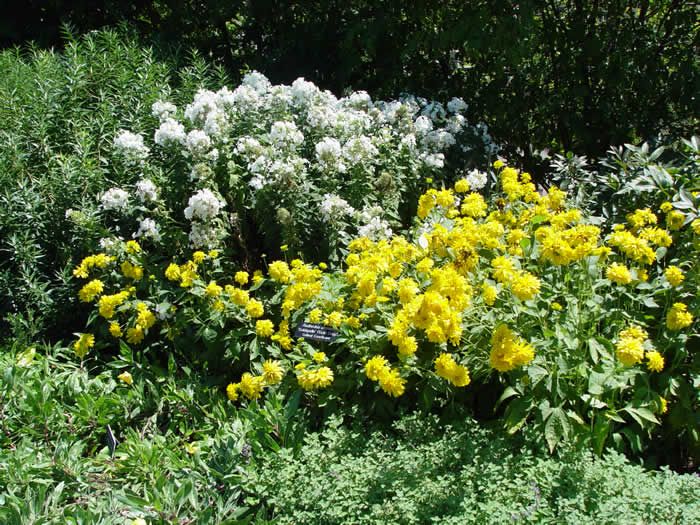How to Design and Install a Rain Garden
Are you curious about how to design, install, and maintain a rain garden for your home landscape? If so, you’re in the right spot. Here are our tips on how to choose the best rain garden plants and more.
|
|
|
The location of a rain garden is just as essential as using the correct plants. Water run-off and flow should be kept in mind, as well as ensuring the plants can handle the amount of water coming in.
|
What is a Rain Garden?
A rain garden is a shallow depression designed to capture and infiltrate storm water runoff from your roof or other impervious areas around your home; like driveways, walkways, and even compacted lawn areas. They can be used as a buffer to shoreline areas to capture runoff from the home landscape before it enters a lake, pond, or river. The rain garden is planted with suitable trees, shrubs, flowers, and other plants allowing runoff to infiltrate into the ground and help protect water quality.
In addition to adding beauty to your home landscape, rain gardens can also help protect water quality, by reducing stormwater runoff from your house lot. Storm water runoff is considered one of the main sources of water pollution nation wide. As watersheds become developed, urbanization and an increase in paved surfaces such as parking lots, driveways, and rooftops increase storm water runoff causing rainwater to run off quickly into storm drains and surface waters. Storm water runoff can result in:
- Overall reduction in groundwater recharge.
- Long-term lowering of groundwater tables and loss of stream flow during dry weather.
- Increased erosion.
- Increased water quality impacts caused by pollutants in storm water runoff.
- Flooding – especially more frequent “flash” flooding.
- A rain garden will allow the runoff generated on your property to infiltrate into the ground and help to reduce potential water quality problems. While your individual rain garden may seem like a small contribution, collectively, rain gardens can produce water quality benefits.
Benefits of Rain Gardens
In addition to reducing and filtering storm water runoff and increasing groundwater recharge, rain gardens provide many other benefits. They:
- Provide habitat for wildlife and, with the proper plants, increase the number and diversity of birds and butterflies for those who enjoy watching them.
- Provide an attractive and creative alternative to traditional lawn landscapes.
- Require less maintenance than lawns because they do not need to be mowed, fertilized, or watered once established.
- Increase property values with creative landscaping designs.
- Reduce storm drain overload and flooding if adopted on a community or neighborhood scale.
Locating and Sizing a Rain Garden
- The rain garden should be at least 10 feet from the house so infiltrating water doesn’t seep into the foundation.
- Do not place the rain garden directly over a septic system or near wells and underground utilities.
- A rain garden is never deeper than 12 inches. Your garden depth will depend on the infiltration rate of your garden or personal preference.
- First you need to find out how fast your rain garden location is infiltrating water.
-Dig a hole about the size of a large coffee can and fill it with water.
-Let it soak in for about an hour.
-Next fill hole with water again but this time put a stick (popsickle sticks work great) into side of hole at the water level.
-After one hour measure how many inches the water drops. (clay soils are slow while sandy soils infiltrate fast).
-Take the drop in inches and multiply by 24. You now know how much water, in inches, your soil infiltrates in 1 day. Any number larger than 12 is not necessary because your rain garden will never be deeper than 12 inches. - A simple formula is to measure how many square feet of roof or landscape will lead to your garden. Then divide that number by your infiltration number you got in the previous step (not larger than 12). This is roughly how big your rain garden needs to be to handle a typical Minnesota rain event.
- You are not bound to the size of the rain garden in the previous step or its depth. Feel free to make it bigger or smaller based on your landscape needs or wants. Some storm water capture is better than none at all.
Designing and Installing a Rain Garden
Take time to completely read through these references as your first step to creating a rain garden.
Where you choose to locate the rain garden is important and you should take the time to assess the conditions in your yard to determine the most appropriate place.
- A rain garden is a flat bottom depression with side slopes not exceeding a 3:1 ratio. Flat bottom allows for maximum surface area for water infiltration.
- Figure out how the water is going to get to the rain garden. Common methods include downspouts, drain tile or over land via a small swale.
- Place some stones where the water enters the garden to prevent erosion.
- Make sure that you know where the rain garden will overflow in heavy rain events. This will help prevent overflow from going where you do not want it to go, like your foundation. Put the overflow area away from any structures or areas you want to keep dry.
- It is better to build the rain garden in full or partial sun, not directly under a tree. The heavy root system of a tree will interfere with installation and plants health.

- It may be tempting to put the rain garden in a part of the yard where water already collects. Don’t! The goal of a rain garden is to encourage infiltration before it settles in the low spot.
- Water should only pool in your rain garden for about 24 hours after rainfall before it has completely infiltrated into the ground. This is important for both the plants as well as mosquito concerns.
- When it comes to design the only limitation is your imagination. Use any shape you want and add any landscape elements (stone, walls, etc.) you want. This is where you can let the creativity flow.
Choosing the Right Plants
It is best to use native, non-invasive species that are resistant to the stress from both brief periods of pooling as well as dry periods between rainfall events. A variety of plants with large root structures will make your rain garden more effective and less susceptible to disease. It is also better to use plants with a developed root structure instead of starting plants by seed. Seeds will have a hard time establishing in the conditions of a rain garden and will also leave the soil exposed and prone to erosion.Select plants based on a combination of aesthetic beauty, wildlife value, and maintenance. Container plants or plants with a well-established root system are important when starting a rain garden to guard against soil erosion and plant wash-out.
Suggestions for rain garden plants include:
Trees:
Red Maple, Acer rubrum
River Birch, Betula nigra
Eastern Red Cedar, Juniperus virginiana
American Hop Hornbeam or Ironwood, Ostrya virginiana
Swamp White Oak, Quercus bicolor
Pin Oak, Quercus palustris
Red Oak, Quercus rubra
Shrubs and Vines:
Black Chokeberry, Aronia melanocarpa
Summersweet, Clethra alnifolia
Red Twig Dogwood, Cornus baileyi
Gray Dogwood, Cornus racemosa
Witchhazel, Hammamelis virginiana
Winterberry, Ilex verticillata
Trumpet Honeysuckle, Lonicera
Virginia Creeper, Parthenocissus inserta
Engelman Ivy, Parthenocissus quinquefolia
American Arborvitae, Thuja occidentalis
*Northern Arrowwood, Viburnum dentatum
Nannyberry, Viburnum lentago
Perennials and Herbaceous Plants
Northern Maidenhair Fern, Adiantum pedatum
Aster, Aster dumosus
New England Aster, Aster novae-angliae
Tufted Hair Grass, Deschampsia cespitosa
Interrupted Fern, Osmunda claytonia
Switchgrass, Panicum virgatum
Rain Garden Cost
 |
|
This is an example of a large, ideal rain garden. Permeable pavement and hardscapes, along with gravel, appropriate water-affinity plants and areas to absorb water (Grass) are all signs of a rain garden.
|
Rain Garden Maintenance
While the plants in your rain garden are young and becoming established they may require some supplemental water during dry periods, though this should only be the case for the first year. Some weeding may also be required the few years until the plants fill out and can out-compete weeds.Once the rain garden has become established maintenance is minimal and will generally only include periodic mulching, pruning and thinning, and plant replacement. Be sure to inspect your rain garden periodically during and/or immediately after rainfall events to be sure the rain garden is working as designed.

